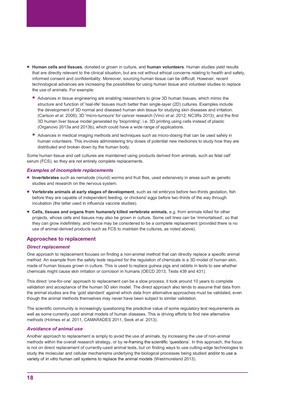
18
Human cells and tissues, donated or grown in culture, and human volunteers. Human studies yield results
that are directly relevant to the clinical situation, but are not without ethical concerns relating to health and safety,
informed consent and confidentiality. Moreover, sourcing human tissue can be difficult. However, recent
technological advances are increasing the possibilities for using human tissue and volunteer studies to replace
the use of animals. For example:
Advances in tissue engineering are enabling researchers to grow 3D human tissues, which mimic the
structure and function of 'real-life' tissues much better than single-layer (2D) cultures. Examples include
the development of 3D normal and diseased human skin tissue for studying skin diseases and irritation.
(Carlson et al. 2008); 3D 'micro-tumours' for cancer research (Vinci et al. 2012; NC3Rs 2013); and the first
3D human liver tissue model generated by 'bioprinting', i.e. 3D printing using cells instead of plastic
(Organovo 2013a and 2013b), which could have a wide range of applications.
Advances in medical imaging methods and techniques such as micro-dosing that can be used safely in
human volunteers. This involves administering tiny doses of potential new medicines to study how they are
distributed and broken down by the human body.
Some human tissue and cell cultures are maintained using products derived from animals, such as fetal calf
serum (FCS), so they are not entirely complete replacements.
Examples of incomplete replacements
Invertebrates such as nematode (round) worms and fruit flies, used extensively in areas such as genetic
studies and research on the nervous system.
Vertebrate animals at early stages of development, such as rat embryos before two-thirds gestation, fish
before they are capable of independent feeding, or chickens' eggs before two-thirds of the way through
incubation (the latter used in influenza vaccine studies).
Cells, tissues and organs from humanely killed vertebrate animals, e.g. from animals killed for other
projects, whose cells and tissues may also be grown in culture. Some cell lines can be "immortalised", so that
they can grow indefinitely, and hence may be considered to be a complete replacement (provided there is no
use of animal-derived products such as FCS to maintain the cultures, as noted above).
Approaches to replacement
Direct replacement
One approach to replacement focuses on finding a non-animal method that can directly replace a specific animal
method. An example from the safety tests required for the regulation of chemicals is a 3D model of human skin,
made of human tissues grown in culture. This is used to replace guinea pigs and rabbits in tests to see whether
chemicals might cause skin irritation or corrosion in humans (OECD 2013, Tests 439 and 431).
This direct "one-for-one" approach to replacement can be a slow process; it took around 10 years to complete
validation and acceptance of the human 3D skin model. The direct approach also tends to assume that data from
the animal studies are the "gold standard" against which data from alternative approaches must be validated, even
though the animal methods themselves may never have been subject to similar validation.
The scientific community is increasingly questioning the predictive value of some regulatory test requirements as
well as some currently used animal models of human diseases. This is driving efforts to find new alternative
methods (Holmes et al. 2011, CAMARADES 2011, Seok et al. 2013).
Avoidance of animal use
Another approach to replacement is simply to avoid the use of animals, by increasing the use of non-animal
methods within the overall research strategy, or by re-framing the scientific "questions". In this approach, the focus
is not on direct replacement of currently-used animal tests, but on finding ways to use cutting-edge technologies to
study the molecular and cellular mechanisms underlying the biological processes being studied and/or to use a
variety of in vitro human cell systems to replace the animal models (Westmoreland 2013).